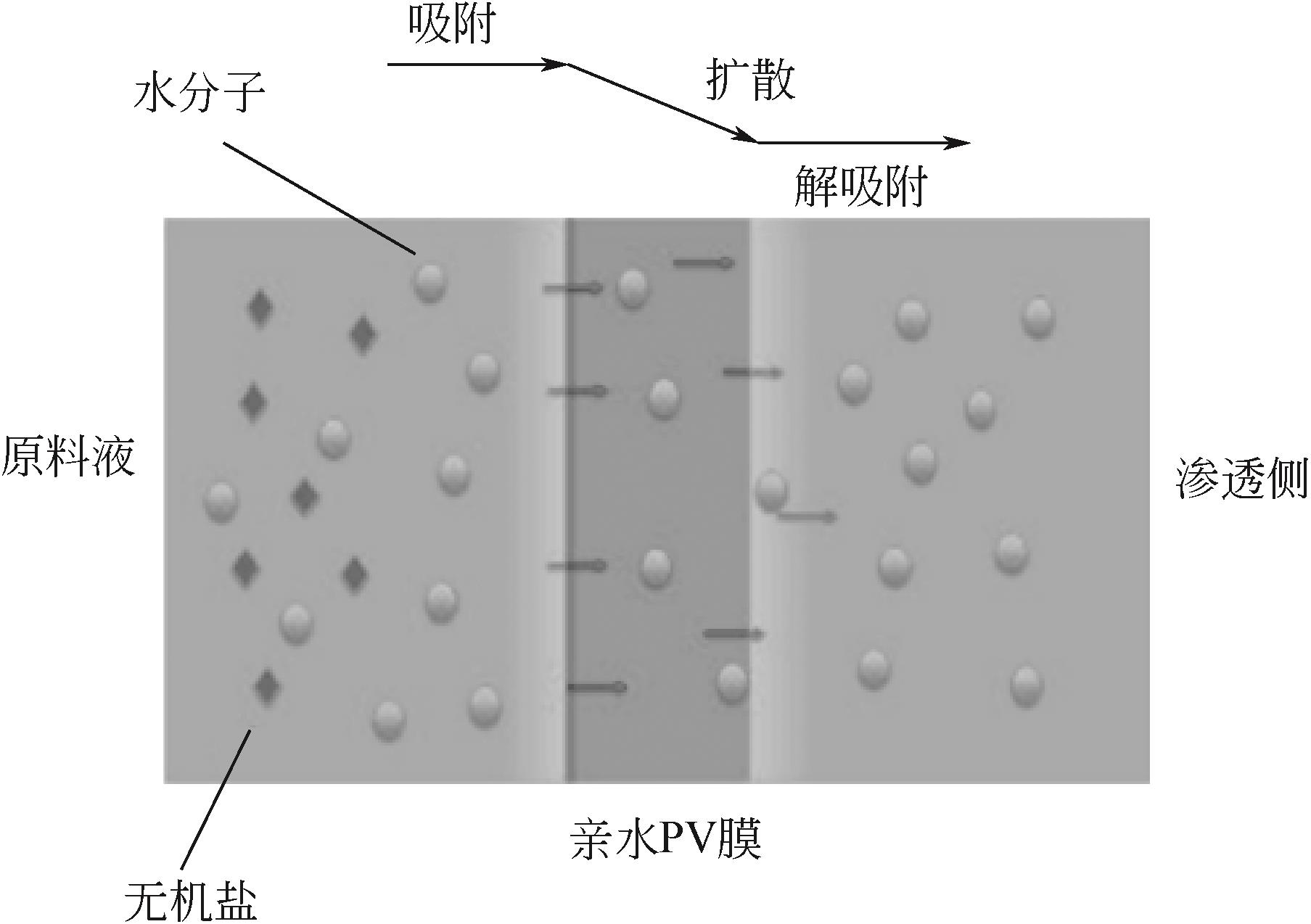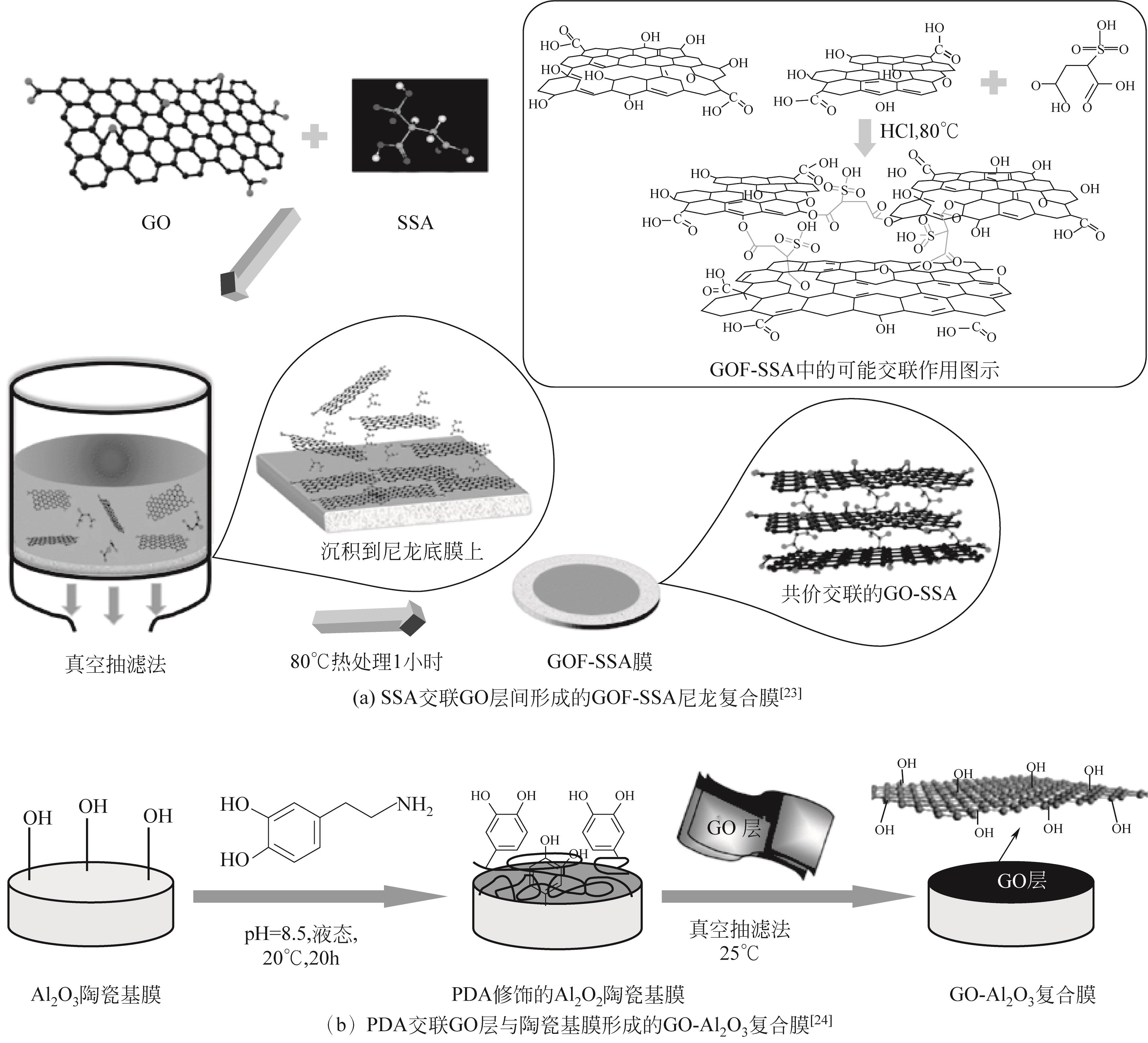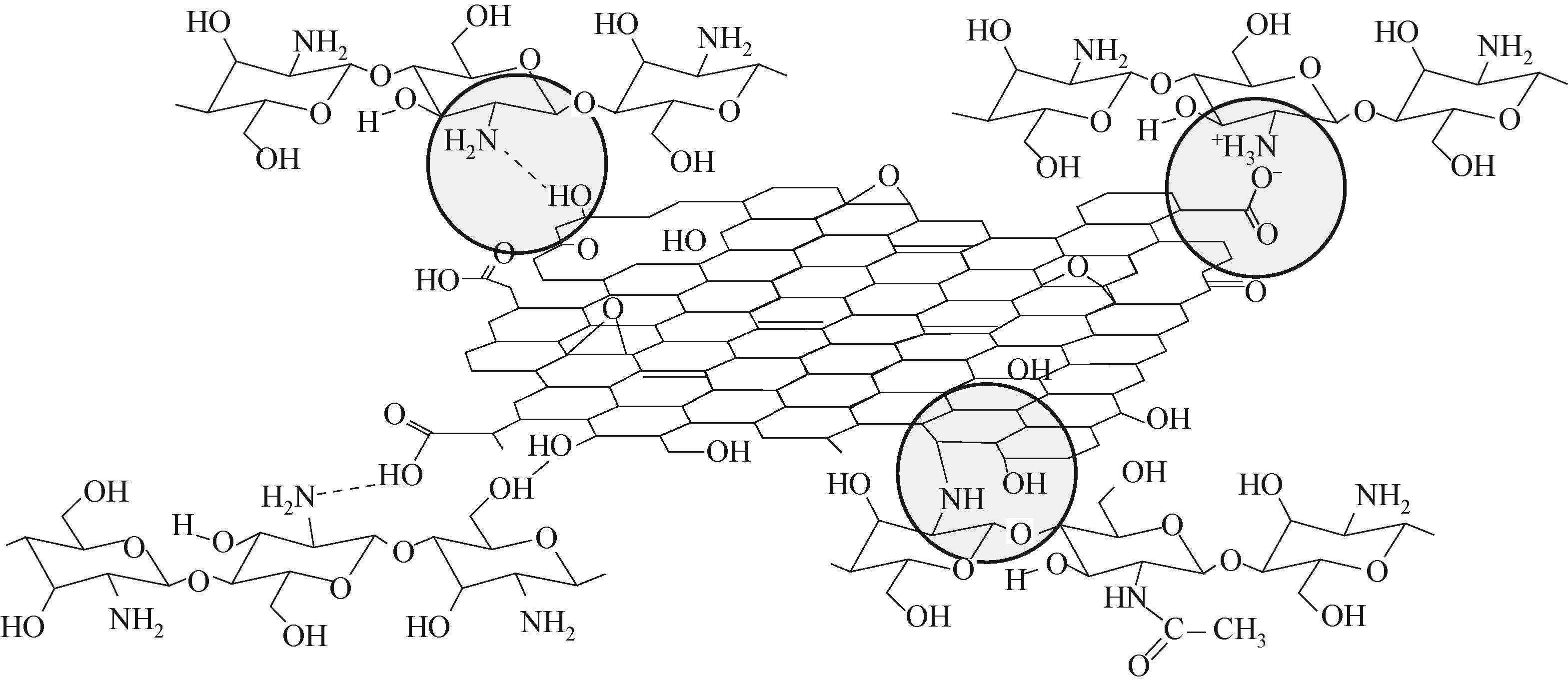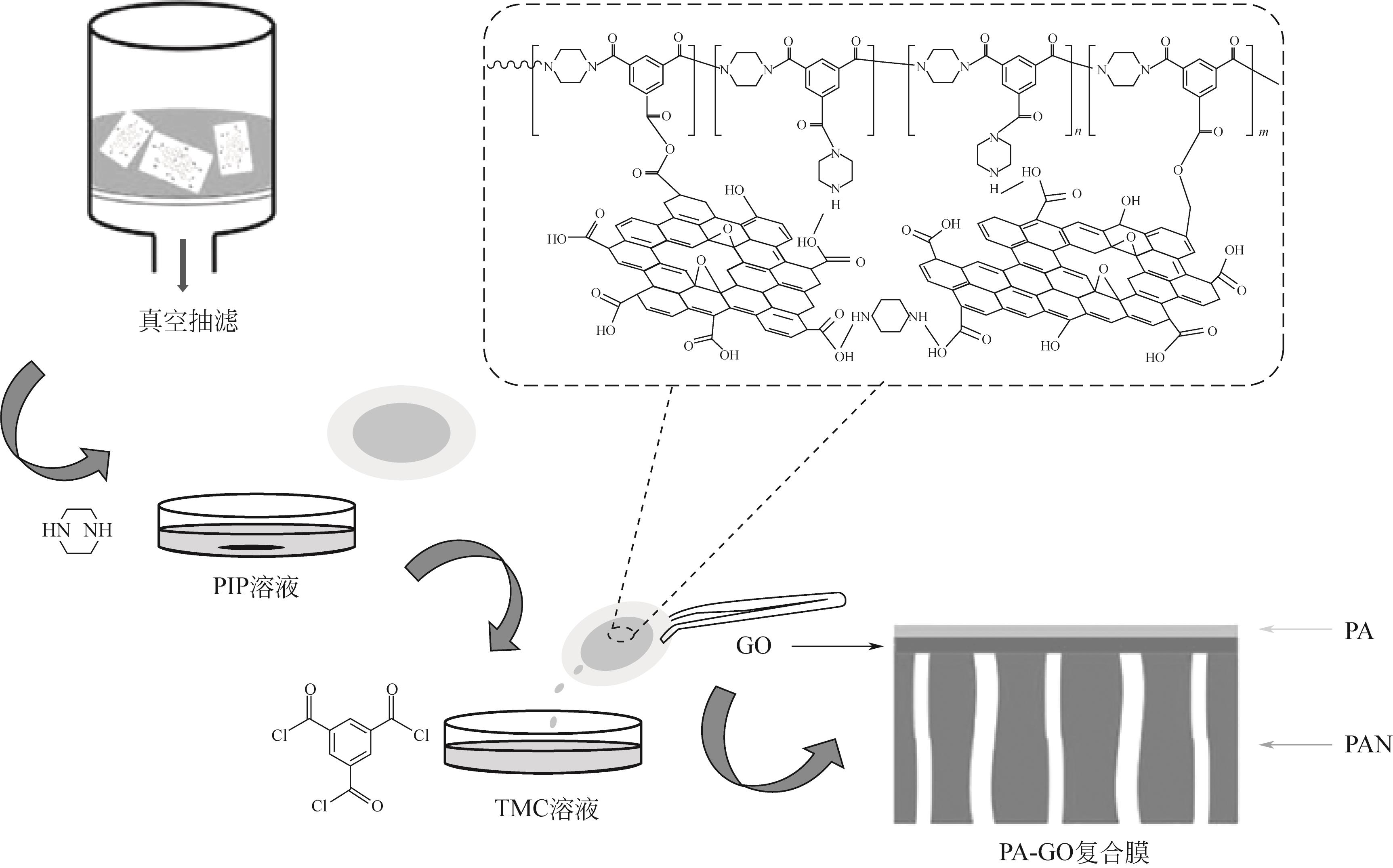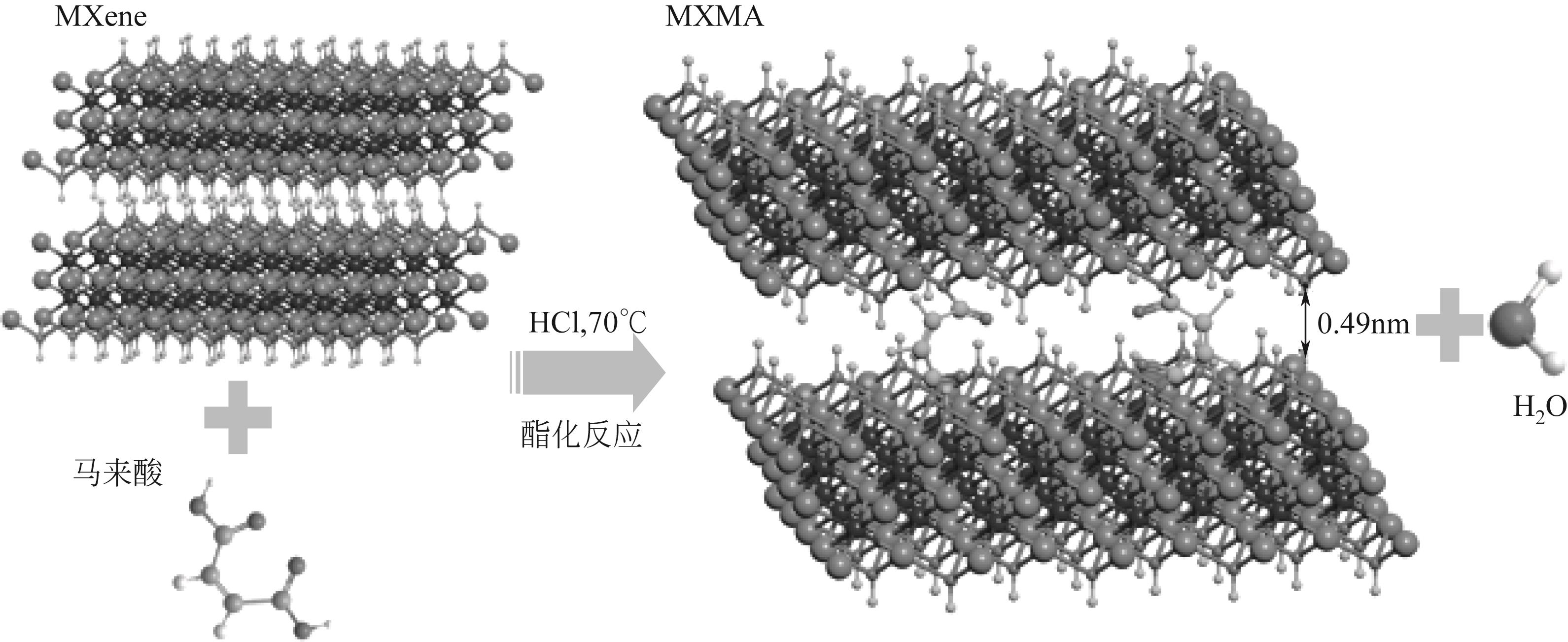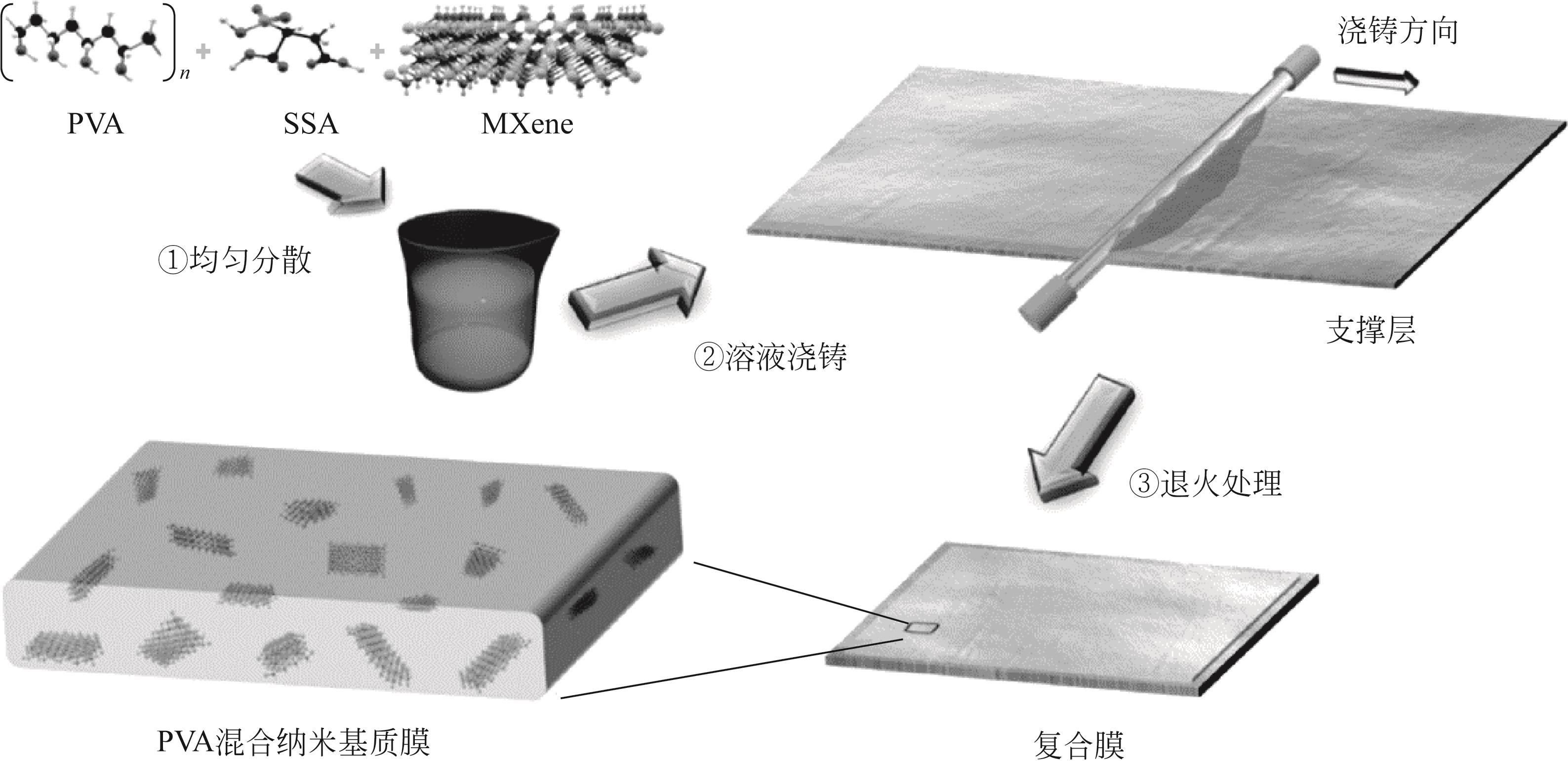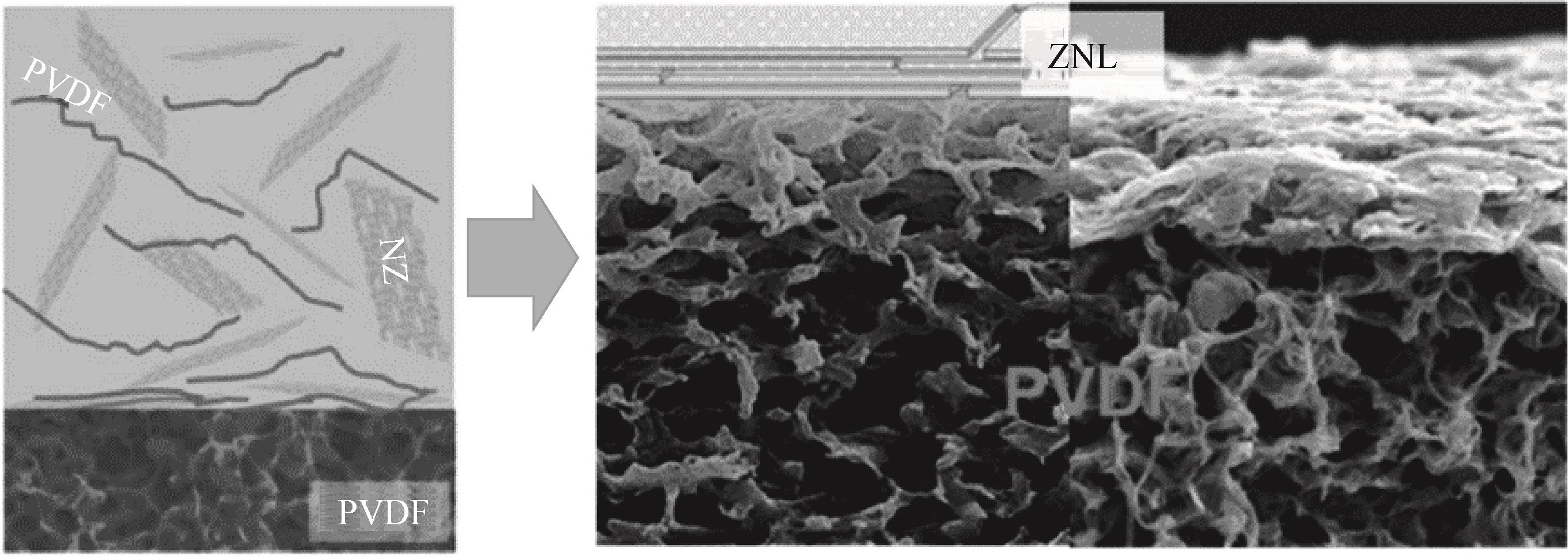Chemical Industry and Engineering Progress ›› 2023, Vol. 42 ›› Issue (3): 1437-1447.DOI: 10.16085/j.issn.1000-6613.2022-0967
• Materials science and technology • Previous Articles Next Articles
Application of two-dimensional nanomaterials in pervaporation desalination membrane
CHEN Yi1( ), GUO Yaoli1,2, YE Haixing3, LI Yuxuan1, NIU Q.Jason1(
), GUO Yaoli1,2, YE Haixing3, LI Yuxuan1, NIU Q.Jason1( )
)
- 1.Institute of Advance Study, Shenzhen University, Shenzhen 518000, Guangdong, China
2.State Key Laboratory of Heavy Oil Processing, China University of Petroleum (East China), Qingdao 266580, Shandong, China
3.School of Materials Science andEngineering, China University of Petroleum (East China), Qingdao 266580, Shandong, China
-
Received:2022-05-24Revised:2022-08-10Online:2023-04-10Published:2023-03-15 -
Contact:NIU Q.Jason
二维纳米材料在渗透汽化脱盐膜中的应用
陈仪1( ), 郭耀励1,2, 叶海星3, 李宇璇1, 牛青山1(
), 郭耀励1,2, 叶海星3, 李宇璇1, 牛青山1( )
)
- 1.深圳大学高等研究院,广东 深圳 518000
2.中国石油大学(华东)重质油国家重点实验室,山东 青岛 266580
3.中国石油大学(华东)材料科学与工程学院,山东 青岛 266580
-
通讯作者:牛青山 -
作者简介:陈仪(1998—),女,硕士研究生,研究方向为渗透汽化脱盐。E-mail:2016101054@email.szu.edu.cn。 -
基金资助:国家自然基金委联合基金重点项目(U2006230);深圳市科创委基础研究面上项目(JCYJ20210324095202008)
CLC Number:
Cite this article
CHEN Yi, GUO Yaoli, YE Haixing, LI Yuxuan, NIU Q.Jason. Application of two-dimensional nanomaterials in pervaporation desalination membrane[J]. Chemical Industry and Engineering Progress, 2023, 42(3): 1437-1447.
陈仪, 郭耀励, 叶海星, 李宇璇, 牛青山. 二维纳米材料在渗透汽化脱盐膜中的应用[J]. 化工进展, 2023, 42(3): 1437-1447.
share this article
Add to citation manager EndNote|Ris|BibTeX
URL: https://hgjz.cip.com.cn/EN/10.16085/j.issn.1000-6613.2022-0967
| PV脱盐膜 | 制备方法 | NaCl浓度 /g·L-1 | 实验条件 | 渗透通量 /L∙m-2∙h-1 | 截留率 /% | 参考 文献 |
|---|---|---|---|---|---|---|
| GO/聚丙烯腈 | 真空抽滤法 | 3.5 | 90℃,真空0.1kPa | 65.1 | 99.8 | [ |
| GO/多巴胺-α-氧化铝 | 真空抽滤法 | 3.5 | 90℃,真空 | 48.4 | 99.7 | [ |
| 氧化石墨烯骨架(GOF)/对苯二异氰酸酯-α-氧化铝 | 真空抽滤法 | 3.5 | 90℃,真空 | 11.4 | 99.9 | [ |
| GO-聚乙烯醇/聚丙烯腈 | 真空抽滤法 | 3.5 | 70℃,真空0.1kPa | 69.1 | 99.9 | [ |
| GO-聚乙烯醇/聚偏氟乙烯(PVDF) | 溶液铸膜法 | 10 | 65℃,真空24kPa | 28 | 99.9 | [ |
| GO-聚酰亚胺 | 相转化法 | 3.5 | 90℃,真空100kPa | 36.1 | 99.9 | [ |
| GO-壳聚糖 | 溶液铸膜法 | 5 | 81℃,真空6kPa | 30 | 99.9 | [ |
| GO-聚酰亚胺纤维 | 相转化法 | 3.5 | 90℃,真空100kPa | 15.6 | 99.9 | [ |
| 纳米石墨烯材料(GNPs)-聚醚嵌段酰胺/聚四氟乙烯 | 相转化法 | 马尔马拉海水 | 35℃,真空0.1kPa | 2.5 | 99.8 | [ |
| GOF/多巴胺-α-氧化铝 | 真空抽滤法 | 3.5 | 90℃,真空 | 20.1 | 99.9 | [ |
| 二胺分子交联 GO/多巴胺(PDA)-α-氧化铝 | 真空抽滤法 | 3.5 | 90℃,真空 | 19.7 | 99.9 | [ |
| GO/聚碳酸酯 | 抽滤涂层法 | 10 | 70℃,真空3kPa | 42.4 | 99.9 | [ |
| GOF-磺基琥珀酸/尼龙底膜 | 真空抽滤法 | 3.5 | 70℃,真空0.13kPa | 80.1 | 99.9 | [ |
| GO/聚丙烯中空纤维膜 | 真空抽滤法 | 3.321 | 70℃,真空 | 11.5 | 99.9 | [ |
| GO/海藻酸钠/聚甲基丙烯酸甲酯 | 溶液铸膜法 | 3 | 60℃,真空0.1kPa | 8.11 | 99.41 | [ |
| GO-聚醚酰亚胺/聚酰胺 | 层层组装法 | 5 | 65℃,真空1.7kPa | 13 | 99.9 | [ |
| GO-聚乙烯醇/混合纤维素膜 | 压力辅助抽滤法 | 10 | 85℃,真空6kPa | 98 | 99.9 | [ |
| 聚酰胺/GO/聚丙烯腈 | 压力辅助抽滤法 | 3.5 | 70℃,真空0.2kPa | 26.7 | 99.9 | [ |
| 阳离子交联-GO膜 | 真空抽滤法 | 纯水 | 20~25℃,真空2.8kPa | 16.16 | — | [ |
| 壳聚糖-氧化石墨烯(CGO)-二甲基苯磺酸/聚丙烯 | 压力辅助抽滤法 | 1.752 | 70℃,真空-95kPa | 30.5 | 99.9 | [ |
| GO-Zn2+/聚醚砜 | 真空抽滤法 | 3 | 60℃,真空-100kPa | 47.8 | 99.9 | [ |
| MXene/聚丙烯腈 | 真空抽滤法 | 3.5 | 65℃,真空0.4kPa | 85.4 | 99.5 | [ |
| MXene-马来酸/尼龙底膜 | 真空抽滤法 | 3.5 | 65℃,真空0.1kPa | 70 | 99 | [ |
| MXene-聚乙烯醇/聚四氟乙烯 | 溶液铸膜法 | 3.5 | 30℃,真空0.13kPa | 62.2 | 99.8 | [ |
| ZSM-5/α-氧化铝 | 浸涂法 | 24 | 80℃,真空1kPa | 6.4 | 99.5 | [ |
| AEL-聚酰胺/α-氧化铝 | 真空抽滤法 | 3.6 | 25℃,真空 | 3.3 | 99.9 | [ |
| ZSM-5/聚偏氟乙烯 | 真空抽滤法 | 22(混合盐) | 73℃±2℃,真空 | 11 | 99.9 | [ |
| PV脱盐膜 | 制备方法 | NaCl浓度 /g·L-1 | 实验条件 | 渗透通量 /L∙m-2∙h-1 | 截留率 /% | 参考 文献 |
|---|---|---|---|---|---|---|
| GO/聚丙烯腈 | 真空抽滤法 | 3.5 | 90℃,真空0.1kPa | 65.1 | 99.8 | [ |
| GO/多巴胺-α-氧化铝 | 真空抽滤法 | 3.5 | 90℃,真空 | 48.4 | 99.7 | [ |
| 氧化石墨烯骨架(GOF)/对苯二异氰酸酯-α-氧化铝 | 真空抽滤法 | 3.5 | 90℃,真空 | 11.4 | 99.9 | [ |
| GO-聚乙烯醇/聚丙烯腈 | 真空抽滤法 | 3.5 | 70℃,真空0.1kPa | 69.1 | 99.9 | [ |
| GO-聚乙烯醇/聚偏氟乙烯(PVDF) | 溶液铸膜法 | 10 | 65℃,真空24kPa | 28 | 99.9 | [ |
| GO-聚酰亚胺 | 相转化法 | 3.5 | 90℃,真空100kPa | 36.1 | 99.9 | [ |
| GO-壳聚糖 | 溶液铸膜法 | 5 | 81℃,真空6kPa | 30 | 99.9 | [ |
| GO-聚酰亚胺纤维 | 相转化法 | 3.5 | 90℃,真空100kPa | 15.6 | 99.9 | [ |
| 纳米石墨烯材料(GNPs)-聚醚嵌段酰胺/聚四氟乙烯 | 相转化法 | 马尔马拉海水 | 35℃,真空0.1kPa | 2.5 | 99.8 | [ |
| GOF/多巴胺-α-氧化铝 | 真空抽滤法 | 3.5 | 90℃,真空 | 20.1 | 99.9 | [ |
| 二胺分子交联 GO/多巴胺(PDA)-α-氧化铝 | 真空抽滤法 | 3.5 | 90℃,真空 | 19.7 | 99.9 | [ |
| GO/聚碳酸酯 | 抽滤涂层法 | 10 | 70℃,真空3kPa | 42.4 | 99.9 | [ |
| GOF-磺基琥珀酸/尼龙底膜 | 真空抽滤法 | 3.5 | 70℃,真空0.13kPa | 80.1 | 99.9 | [ |
| GO/聚丙烯中空纤维膜 | 真空抽滤法 | 3.321 | 70℃,真空 | 11.5 | 99.9 | [ |
| GO/海藻酸钠/聚甲基丙烯酸甲酯 | 溶液铸膜法 | 3 | 60℃,真空0.1kPa | 8.11 | 99.41 | [ |
| GO-聚醚酰亚胺/聚酰胺 | 层层组装法 | 5 | 65℃,真空1.7kPa | 13 | 99.9 | [ |
| GO-聚乙烯醇/混合纤维素膜 | 压力辅助抽滤法 | 10 | 85℃,真空6kPa | 98 | 99.9 | [ |
| 聚酰胺/GO/聚丙烯腈 | 压力辅助抽滤法 | 3.5 | 70℃,真空0.2kPa | 26.7 | 99.9 | [ |
| 阳离子交联-GO膜 | 真空抽滤法 | 纯水 | 20~25℃,真空2.8kPa | 16.16 | — | [ |
| 壳聚糖-氧化石墨烯(CGO)-二甲基苯磺酸/聚丙烯 | 压力辅助抽滤法 | 1.752 | 70℃,真空-95kPa | 30.5 | 99.9 | [ |
| GO-Zn2+/聚醚砜 | 真空抽滤法 | 3 | 60℃,真空-100kPa | 47.8 | 99.9 | [ |
| MXene/聚丙烯腈 | 真空抽滤法 | 3.5 | 65℃,真空0.4kPa | 85.4 | 99.5 | [ |
| MXene-马来酸/尼龙底膜 | 真空抽滤法 | 3.5 | 65℃,真空0.1kPa | 70 | 99 | [ |
| MXene-聚乙烯醇/聚四氟乙烯 | 溶液铸膜法 | 3.5 | 30℃,真空0.13kPa | 62.2 | 99.8 | [ |
| ZSM-5/α-氧化铝 | 浸涂法 | 24 | 80℃,真空1kPa | 6.4 | 99.5 | [ |
| AEL-聚酰胺/α-氧化铝 | 真空抽滤法 | 3.6 | 25℃,真空 | 3.3 | 99.9 | [ |
| ZSM-5/聚偏氟乙烯 | 真空抽滤法 | 22(混合盐) | 73℃±2℃,真空 | 11 | 99.9 | [ |
| 1 | WERBER J R, OSUJI C O, ELIMELECH M. Materials for next-generation desalination and water purification membranes[J]. Nature Reviews Materials, 2016, 1: 16018. |
| 2 | CULLMANN J, DILLEY M, EGERTON P, et al. 2021 state of climate services: Water[R/OL]. WMO, 2021. ,climate%20adaptation%2C%20sustainable%20development%20and%20disaster%20risk%20reduction. |
| 3 | 蒙俊权.聚乙烯醇渗透汽化脱盐复合膜的制备及性能研究[D]. 北京: 北京化工大学, 2021. |
| MENG Junquan. Study on preparation and performance of polyvinyl alcohol pervaporation desalination composite membranes[D]. Beijing: Beijing University of Chemical Technology, 2021. | |
| 4 | LEE A, ELAM J W, DARLING S B. Membrane materials for water purification: design, development, and application[J]. Environmental Science: Water Research & Technology, 2016, 2(1): 17-42. |
| 5 | 邱柯卫, 苏伟, 孙志猛, 等. 渗透蒸发脱盐技术研究进展[J]. 膜科学与技术, 2020, 40(6): 133-140. |
| QIU Kewei, SU Wei, SUN Zhimeng, et al. Review on desalination technology by pervaporation[J]. Membrane Science and Technology, 2020, 40(6): 133-140. | |
| 6 | CASTRO-MUÑOZ R. Breakthroughs on tailoring pervaporation membranes for water desalination: a review[J]. Water Research, 2020, 187: 116428. |
| 7 | WANG Q Z, LI N, BOLTO B, et al. Desalination by pervaporation: a review[J]. Desalination, 2016, 387: 46-60. |
| 8 | KAMINSKI W, MARSZALEK J, TOMCZAK E. Water desalination by pervaporation—comparison of energy consumption[J]. Desalination, 2018, 433: 89-93. |
| 9 | PRIHATININGTYAS I, VAN DER BRUGGEN B. Nanocompositepervaporation membrane for desalination[J]. Chemical Engineering Research and Design, 2020, 164: 147-161. |
| 10 | TEOW Y H, MOHAMMAD A W. New generation nanomaterials for water desalination: a review[J]. Desalination, 2019, 451: 2-17. |
| 11 | 李胄彦, 戴若彬, 李洋, 等. 基于二维纳米材料的水处理功能膜研究进展[J]. 化工进展, 2021, 40(8): 4117-4126. |
| LI Zhouyan, DAI Ruobin, LI Yang, et al. Research progress of functional membranes based on two-dimensional nanomaterials for water treatment[J]. Chemical Industry and Engineering Progress, 2021, 40(8): 4117-4126. | |
| 12 | LIU Gongping, JIN Wanqin, XU Nanping. Graphene-based membranes[J]. Chemical Society Reviews, 2015, 44(15): 5016-5030. |
| 13 | 万武波, 纪冉, 何锋. 石墨烯基分离膜研究进展[J]. 化学进展, 2017, 29(8): 833-845. |
| WAN Wubo, JI Ran, HE Feng. Recent advances in graphene based separation membranes[J]. Progress in Chemistry, 2017, 29(8): 833-845. | |
| 14 | LIU Yi. Beyond graphene oxides: emerging 2D molecular sieve membranes for efficient separation[J]. Chinese Journal of Chemical Engineering, 2019, 27(6): 1257-1271. |
| 15 | CASTRO-MUÑOZ R, CRUZ-CRUZ A, ALFARO-SOMMERS Y, et al. Reviewing the recent developments of using graphene-based nanosized materials in membrane separations[J]. Critical Reviews in Environmental Science and Technology, 2022, 52(19): 3415-3452. |
| 16 | 芦瑛, 张林, 李明, 等. 氧化石墨烯基水处理膜研究进展[J]. 科技导报, 2015, 33(14): 32-35. |
| LU Ying, ZHANG Lin, LI Ming, et al. Research progress of graphene oxide based membrane in water treatment[J]. Science & Technology Review, 2015, 33(14): 32-35. | |
| 17 | 张晴, 任文才, 成会明. 石墨烯基分离膜研究进展[J]. 中国材料进展, 2019, 38(9): 887-896. |
| ZHANG Qing, REN Wencai, CHENG Huiming. Research progress of graphene-based separation membranes[J]. Materials China, 2019, 38(9): 887-896. | |
| 18 | SUN Pengzhan, WANG Kunlin, ZHU Hongwei. Recent developments in graphene-based membranes: structure, mass-transport mechanism and potential applications[J]. Advanced Materials, 2016, 28(12): 2287-2310. |
| 19 | NAIR R R, WU H A, JAYARAM P N, et al. Unimpeded permeation of water through helium-leak-tight graphene-based membranes[J]. Science, 2012, 335(6067): 442-444. |
| 20 | ABRAHAM J, VASU K S, WILLIAMS C D, et al. Tunable sieving of ions using graphene oxide membranes[J]. Nat Nanotechnol, 2017, 12(6): 546-550. |
| 21 | LIANG Bin, ZHAN Wu, QI Genggeng, et al. High performance graphene oxide/polyacrylonitrile composite pervaporation membranes for desalination applications[J]. Journal of Materials Chemistry A, 2015, 3(9): 5140-5147. |
| 22 | HALAKOO E, FENG X S. Layer-by-layer assembly of polyethyleneimine/graphene oxide membranes for desalination of high-salinity water via pervaporation[J]. Separation and Purification Technology, 2020, 234: 116077. |
| 23 | YANG Guang, XIE Zongli, CRAN Ma, et al. Functionalizing graphene oxide framework membranes with sulfonic acid groups for superior aqueous mixture separation[J]. Journal of Materials Chemistry A, 2019, 7(34): 19682-19690. |
| 24 | XU Kai, FENG Bo, ZHOU Chen, et al. Synthesis of highly stable graphene oxide membranes on polydopamine functionalized supports for seawater desalination[J]. Chemical Engineering Science, 2016, 146: 159-165. |
| 25 | QIAN Yunlong, ZHOU Chen, HUANG Aisheng. Cross-linking modification with diamine monomers to enhance desalination performance of graphene oxide membranes[J]. Carbon, 2018, 136: 28-37. |
| 26 | CHENG Cheng, SHEN Lingdi, YU Xufeng, et al. Robust construction of a graphene oxide barrier layer on a nanofibrous substrate assisted by the flexible poly(vinylalcohol) for efficient pervaporation desalination[J]. Journal of Materials Chemistry A, 2017, 5(7): 3558-3568. |
| 27 | FENG Bo, XU Kai, HUANG Aisheng. Synthesis of graphene oxide/polyimide mixed matrix membranes for desalination[J]. RSC Advances, 2017, 7(4): 2211-2217. |
| 28 | HUANG Aisheng, FENG Bo. Synthesis of novel graphene oxide-polyimide hollow fiber membranes for seawater desalination[J]. Journal of Membrane Science, 2018, 548: 59-65. |
| 29 | QIAN Xiaowei, LI Na, WANG Qinzhuo, et al. Chitosan/graphene oxide mixed matrix membrane with enhanced water permeability for high-salinity water desalination by pervaporation[J]. Desalination, 2018, 438: 83-96. |
| 30 | ALMARZOOQI K, ASHRAFI M, KANTHAN T, et al. Graphene oxide membranes for high salinity, produced water separation by pervaporation[J]. Membranes, 2021, 11(7): 475. |
| 31 | CHING K, LIAN B Y, LESLIE G, et al. Metal-cation-modified graphene oxide membranes for water permeation[J]. Carbon, 2020, 170: 646-657. |
| 32 | ZHAO Xiaoying, TONG Ziqiang, LIU Xiufeng, et al. Facile preparation of polyamide-graphene oxide composite membranes for upgrading pervaporation desalination performances of hypersaline solutions[J]. Industrial & Engineering Chemistry Research, 2020, 59(26): 12232-12238. |
| 33 | CHA-UMPONG W, DONG G X, RAZMJOU A, et al. Effect of oscillating temperature and crystallization on graphene oxide composite pervaporation membrane for inland brine desalination[J]. Journal of Membrane Science, 2019, 588: 117210. |
| 34 | CHA-UMPONG W, MAYYAS M, RAZMJOU A, et al. Modification of GO-based pervaporation membranes to improve stability in oscillating temperature operation[J]. Desalination, 2021, 516: 115215. |
| 35 | WYATT B C, ROSENKRANZ A, ANASORI B. 2D MXenes: tunable mechanical and tribologicalproperties[J]. Advanced Materials, 2021, 33(17): e2007973. |
| 36 | VAHIDMOHAMMADI A, ROSEN J, GOGOTSI Y. The world of two-dimensional carbides and nitrides (MXenes)[J]. Science, 2021, 372(6547): eabf1581. |
| 37 | 郑伟, 孙正明, 张培根, 等. 二维纳米材料MXene的研究进展[J]. 材料导报, 2017, 31(9): 1-14. |
| ZHENG Wei, SUN Zhengming, ZHANG Peigen, et al. Research progress on MXene, two dimensional nano-materials[J]. Materials Review, 2017, 31(9): 1-14. | |
| 38 | 曾广勇, 王彬, 张俊, 等. 二维MXene膜的构筑及在水处理应用中的研究进展[J]. 复合材料学报, 2021, 38(7): 2078-2091. |
| ZENG Guangyong, WANG Bin, ZHANG Jun, et al. Construction of two-dimensional MXene membrane and its research progress of application in water treatment[M]. Acta Materiae Compositae Sinica, 2021, 38(7): 2078-2091 | |
| 39 | RASOOL K, PANDEY R P, RASHEED P A, et al. Water treatment and environmental remediation applications of two-dimensional metal carbides (MXenes)[J]. Materials Today, 2019, 30: 80-102. |
| 40 | WEI Y, ZHANG P, SOOMRO R A, et al. Advances in the synthesis of 2D MXenes[J]. Advanced Materials, 2021, 33(39): e2103148. |
| 41 | LIU Guozhen, SHEN Jie, LIU Quan, et al. Ultrathin two-dimensional MXene membrane for pervaporationdesalination[J]. Journal of Membrane Science, 2018, 548: 548-558. |
| 42 | YANG G, XIE Z L, THORNTON A W, et al. Ultrathin poly(vinyl alcohol)/MXenenanofilm composite membrane with facile intrusion-free construction for pervaporative separations[J]. Journal of Membrane Science, 2020, 614: 118490. |
| 43 | DING Mingmei, XU Hang, CHEN Wei, et al. 2D laminar maleic acid-crosslinkedMXene membrane with tunable nanochannels for efficient and stable pervaporationdesalination[J]. Journal of Membrane Science, 2020, 600: 117871. |
| 44 | 何磊, 么秋香, 孙鸣, 等. 二维(2D)沸石与三维(3D)沸石的制备及催化研究进展[J]. 化学学报, 2022, 80(2): 180-198. |
| HE Lei, YAO Qiuxiang, SUN Ming, et al. Progress in preparation and catalysis of two-dimensional(2D) and three-dimensional(3D) zeolites[J]. ActaChimicaSinica, 2022, 80(2): 180-198. | |
| 45 | LI Yi, YU Jihong. Emerging applications of zeolites in catalysis, separation and host-guest assembly[J]. Nature Reviews Materials, 2021, 6(12): 1156-1174. |
| 46 | PŘECH J, PIZARRO P, SERRANO D P, et al. From 3D to 2D zeolite catalytic materials[J]. Chemical Society Reviews, 2018, 47(22): 8263-8306. |
| 47 | 黄阳环, 张宏斌, 唐颐. 二维沸石及其在大分子催化转化领域的研究进展[J]. 大学化学, 2017, 32(2): 1-8. |
| HUANG Yanghuan, ZHANG Hongbin, TANG Yi. Progress of two-dimensional zeolites and their applications in bulky molecule catalytic conversion[J]. University Chemistry, 2017, 32(2): 1-8. | |
| 48 | ROTH W J, NACHTIGALL P, MORRIS R E, et al. Two-dimensional zeolites: current status and perspectives[J]. Chemical Reviews, 2014, 114(9): 4807-4837. |
| 49 | CAO Zishu, ZENG Shixuan, XU Zhi, et al. Ultrathin ZSM-5 zeolite nanosheet laminated membrane for high-flux desalination of concentrated brines[J]. Science Advances, 2018, 4(11): eaau8634. |
| 50 | CAO Z S, ISKHAKOVA L, SUN X H, et al. ZSM-5 zeolite nanosheet-based membranes on porous polyvinylidene fluoride for high-flux desalination[J]. ACS Applied Nano Materials, 2021, 4(3): 2895-2902. |
| 51 | KORDE A, MIN B, GANESAN A, et al. AEL zeolite nanosheet-polyamide nanocomposite membranes on α-alumina hollow fibers with enhanced pervaporationproperties[J]. Industrial & Engineering Chemistry Research, 2020, 59(33): 14789-14796. |
| 52 | FENG Bo, XU Kai, HUANG Aisheng. Covalent synthesis of three-dimensional graphene oxide framework (GOF) membrane for seawater desalination[J]. Desalination, 2016, 394: 123-130. |
| 53 | LI Lin, HOU Jingwei, YE Yun, et al. Suppressing salt transport through composite pervaporation membranes for brine desalination[J]. Applied Sciences, 2017, 7(8): 856. |
| 54 | NIGIZ F U. Preparation of high-performance graphenenanoplate incorporated polyether block amide membrane and application for seawater desalination[J]. Desalination, 2018, 433: 164-171. |
| 55 | QIAN Yunlong, ZHANG Xiaoling, LIU Chuanyao, et al. Tuning interlayer spacing of graphene oxide membranes with enhanced desalination performance[J].Desalination, 2019, 460: 56-63. |
| 56 | LI L, HOU J W, CHEN V. Pinning down the water transport mechanism in graphene oxide pervaporation desalination membranes[J]. Industrial & Engineering Chemistry Research, 2019, 58(10): 4231-4239. |
| 57 | NIGIZ F U. Graphene oxide‑sodium alginate membrane for seawater desalination through pervaporation[J]. Desalination, 2020, 485: 114465. |
| 58 | SUN Jiawei, QIAN Xiaowei, WANG Ziheng, et al. Tailoring the microstructure of poly(vinyl alcohol)-intercalated graphene oxide membranes for enhanced desalination performance of high-salinity water by pervaporation[J]. Journal of Membrane Science, 2020, 599: 117838. |
| [1] | ZHANG Mingyan, LIU Yan, ZHANG Xueting, LIU Yake, LI Congju, ZHANG Xiuling. Research progress of non-noble metal bifunctional catalysts in zinc-air batteries [J]. Chemical Industry and Engineering Progress, 2023, 42(S1): 276-286. |
| [2] | HU Xi, WANG Mingshan, LI Enzhi, HUANG Siming, CHEN Junchen, GUO Bingshu, YU Bo, MA Zhiyuan, LI Xing. Research progress on preparation and sodium storage properties of tungsten disulfide composites [J]. Chemical Industry and Engineering Progress, 2023, 42(S1): 344-355. |
| [3] | ZHANG Zuoqun, GAO Yang, BAI Chaojie, XUE Lixin. Thin-film nanocomposite (TFN) mixed matrix reverse osmosis (MMRO) membranes from secondary interface polymerization containing in situ grown ZIF-8 nano-particles [J]. Chemical Industry and Engineering Progress, 2023, 42(S1): 364-373. |
| [4] | XU Jie, XIA Longbo, LUO Ping, ZOU Dong, ZHONG Zhaoxiang. Progress in preparation and application of omniphobic membranes for membrane distillation process [J]. Chemical Industry and Engineering Progress, 2023, 42(8): 3943-3955. |
| [5] | PAN Yichang, ZHOU Rongfei, XING Weihong. Advanced microporous membranes for efficient separation of same-carbon-number hydrocarbon mixtures: State-of-the-art and challenges [J]. Chemical Industry and Engineering Progress, 2023, 42(8): 3926-3942. |
| [6] | LI Xuejia, LI Peng, LI Zhixia, JIN Dunshang, GUO Qiang, SONG Xufeng, SONG Peng, PENG Yuelian. Experimental comparation on anti-scaling and anti-wetting ability of hydrophilic and hydrophobic modified membranes [J]. Chemical Industry and Engineering Progress, 2023, 42(8): 4458-4464. |
| [7] | WANG Baoying, WANG Huangying, YAN Junying, WANG Yaoming, XU Tongwen. Research progress of polymer inclusion membrane in metal separation and recovery [J]. Chemical Industry and Engineering Progress, 2023, 42(8): 3990-4004. |
| [8] | TANG Lei, ZENG Desen, LING Ziye, ZHANG Zhengguo, FANG Xiaoming. Research progress of phase change materials and their application systems for cool storage [J]. Chemical Industry and Engineering Progress, 2023, 42(8): 4322-4339. |
| [9] | SHAN Xueying, ZHANG Meng, ZHANG Jiafu, LI Lingyu, SONG Yan, LI Jinchun. Numerical simulation of combustion of flame retardant epoxy resin [J]. Chemical Industry and Engineering Progress, 2023, 42(7): 3413-3419. |
| [10] | LU Shijian, LIU Miaomiao, YANG Fei, ZHANG Junjie, CHEN Siming, LIU Ling, KANG Guojun, LI Qingfang. Gas-liquid two-phase flow and mass transfer characteristics in an improved CO2 wet-wall column [J]. Chemical Industry and Engineering Progress, 2023, 42(7): 3457-3467. |
| [11] | FENG Jianghan, SONG Fang. Research progress of anion exchange membrane water electrolysis cells [J]. Chemical Industry and Engineering Progress, 2023, 42(7): 3501-3509. |
| [12] | YU Zhiqing, HUANG Wenbin, WANG Xiaohan, DENG Kaixin, WEI Qiang, ZHOU Yasong, JIANG Peng. B-doped Al2O3@C support for CoMo hydrodesulfurization catalyst and their hydrodesulfurization performance [J]. Chemical Industry and Engineering Progress, 2023, 42(7): 3550-3560. |
| [13] | CHEN Xiangli, LI Qianqian, ZHANG Tian, LI Biao, LI Kangkang. Research progress on self-healing oil/water separation membranes [J]. Chemical Industry and Engineering Progress, 2023, 42(7): 3600-3610. |
| [14] | LI Jiyan, JING Yanju, XING Guoyu, LIU Meichen, LONG Yong, ZHU Zhaoqi. Research progress and challenges of salt-resistant solar-driven interface photo-thermal materials and evaporator [J]. Chemical Industry and Engineering Progress, 2023, 42(7): 3611-3622. |
| [15] | YANG Jingying, SHI Wansheng, HUANG Zhenxing, XIE Lijuan, ZHAO Mingxing, RUAN Wenquan. Research progress on the preparation of modified nano zero-valent iron materials [J]. Chemical Industry and Engineering Progress, 2023, 42(6): 2975-2986. |
| Viewed | ||||||
|
Full text |
|
|||||
|
Abstract |
|
|||||
